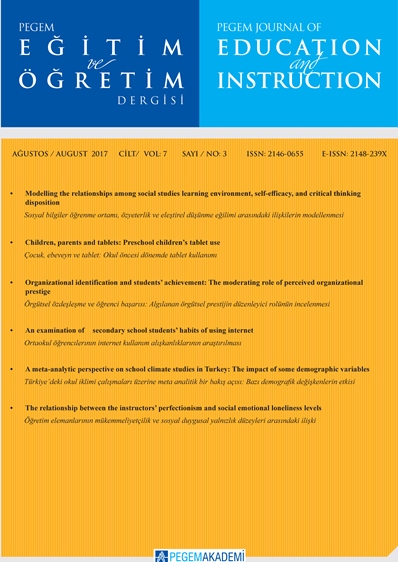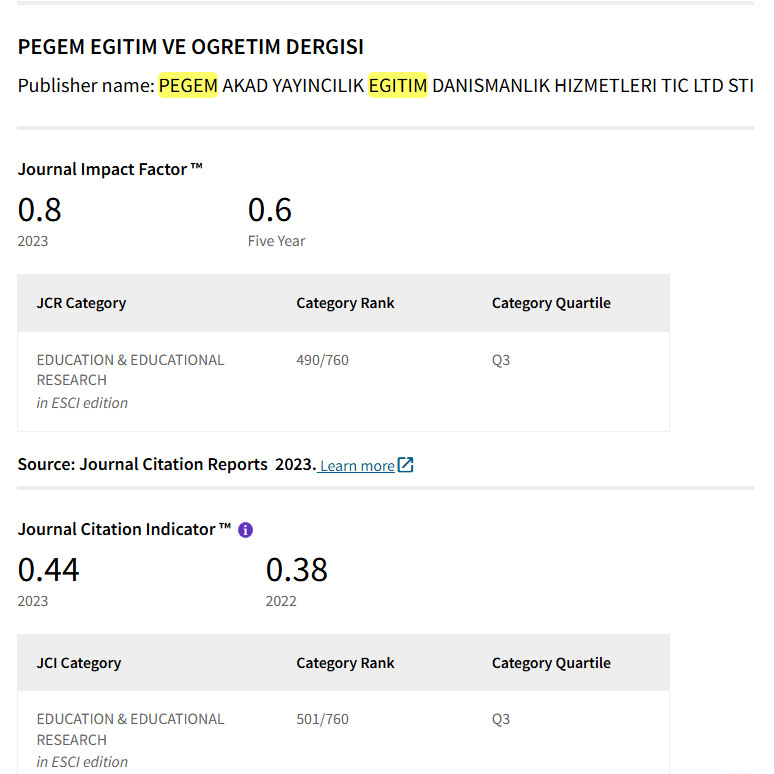Perceived usefulness of jitsi meet in an EFL classroom
DOI:
https://doi.org/10.47750/pegegog.12.01.17Keywords:
Jitsi Meet, Students’ Perception, Learning Tool, EFL Classroom, Video ConferencingAbstract
Particularly in the field of education, technological developments are both quick and vast. Technology such as video conference utilization is a requirement that must be fulfilled. The goals of this study were to: (1) investigate students' perceptions of Jitsi Meet as an effective educational tool; and (2) investigate the impact of Jitsi Meet on EFL learners' perceptions of it as an aid to teaching. The qualitative technique was employed in this study, and the TAM (Technology Acceptance Model) by Davis (1989) served as the theoretical foundation. This research used three instruments: the researcher, an online questionnaire, and interviews. The findings of this study revealed that students had a good attitude about the usage of Jitsi Meet as a learning tool in the EFL classroom, particularly for virtual learning. Jitsi Meet is the ideal option for use as a meeting or discussion tool in and out of the classroom. This research also indicated that some students are willing to utilize Jitsi Meet in the upcoming by its time and location flexibility, minimum internet bandwidth requirements, and multitasking capabilities. However, there are other factors to consider, such as internet reliability and the development of additional learning functions.
Downloads
References
Al-Maroof, R. A. S., & Al-Emran, M. (2018). Students acceptance of google classroom: An exploratory study using PLS-SEM approach. International Journal of Emerging Technologies in Learning, 13(6), 112–123. https://doi.org/10.3991/ijet.v13i06.8275
Basko, L., & Hartman, J. (2017). Increasing Student Engagement Through Paired Technologies. Journal of Instructional Research, 6(1), 24–28. https://doi.org/10.9743/jir.2017.4
Blasco, M. F., & Virto, L. N. R. (2020). E-learning using Video Conferencing Applications : How is Google Meet perceived among students ?
Davis, F. D. (1989). Perceived usefulness, perceived ease of use, and user acceptance of information technology. MIS Quarterly: Management Information Systems. https://doi.org/10.2307/249008
Genc Ilter, B. (2009). Effect of technology on motivation in EFL classrooms. Turkish Online Journal of Distance Education, 10(4), 136–158. https://doi.org/10.17718/tojde.37730
Gillies, D. (2008). Student perspectives on videoconferencing in teacher education at a distance. Distance Education, 29(1), 107–118. https://doi.org/10.1080/01587910802004878
Harsasi, M., & Sutawijaya, A. (2018). Determinants of student satisfaction in online tutorial: A study of a distance education institution. Turkish Online Journal of Distance Education, 19(1), 89–99. https://doi.org/10.17718/tojde.382732
Karal, H., Çebi, A., & Turgut, Y. E. (2011). Perceptions of students who take synchronous courses through video conferencing about distance education. Turkish Online Journal of Educational Technology, 10(4), 276–293.
Martin, M. (2005). Seeing is believing: The role of videoconferencing in distance learning. British Journal of Educational Technology, 36(3), 397–405. https://doi.org/10.1111/j.1467-8535.2005.00471.x
Masrom, M. (2007). Technology acceptance model and E-learning. 12th International Conference on Education, May, 21–24.
Miles, B. M., & Huberman, A. M. (1994). Qualitative Data Analysis An Expanded Sourcebook 2nd Edition (R. Holland (ed.); 2nd ed.). SAGE Publications.
Park, Y., & Bonk, C. (2007). Is online life a breeze? A case study for promoting synchronous learning in a blended graduate course. Journal of Online Learning and Teaching, 3(3), 307–323. http://jolt.merlot.org/vol3no3/park.htm
Sefrika, & Alawiah, T. E. (2020). Acceptance of Video Conference Technology as a Distance Learning Media with the TAM Method. International Journal of Information System & Technology, 4(36), 465–470.
Downloads
Published
How to Cite
Issue
Section
License
Copyright (c) 2021 Pegem Journal of Education and Instruction

This work is licensed under a Creative Commons Attribution-NonCommercial 4.0 International License.
Attribution — You must give appropriate credit, provide a link to the license, and indicate if changes were made. You may do so in any reasonable manner, but not in any way that suggests the licensor endorses you or your use.
NonCommercial — You may not use the material for commercial purposes.
No additional restrictions — You may not apply legal terms or technological measures that legally restrict others from doing anything the license permits.




